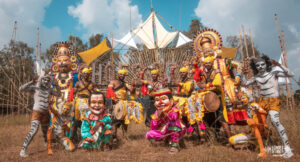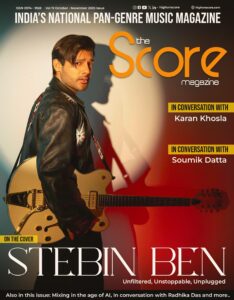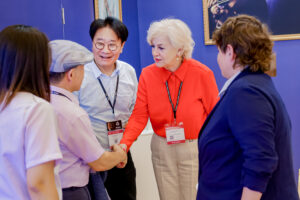Tell us how your started your musical endeavor and how it was to move from a different country and start afresh
Having been born into a very musical household, my journey started from the womb itself. In
fact my first guru was my mother, Smt Shubha Narayan. But as my training went on, I reached a
point around the age of 11 where my parents wanted me to learn from a senior artist in India,
which is when I first moved to Chennai (taking a temporary break from school), and learned
from Shri KS Krishnamurthy. I spent almost about three years learning music from Shri
Krishnamurthy, which really made my interest in Carnatic music shoot up. After his passing in
1999, I began learning from Shri Sanjay Subrahmanyan. Because of my move to Chennai at the
age of 11, and subsequent visits over my high school and college years, the permanent move in
2006 was a much easier transition. I had a great support system in place, in the form of my
guru, musical mentors, my family, and a huge group of friends in Chennai.
Your all time favourite raaga to perform at ANY stage?
One ragam I love to sing on any stage is Durga. It is often considered a lighter ragam in
the Carnatic world, but it is still well received even by the most traditional and hardcore
audiences. And on a stage where listeners may not be as well educated in the deeper
aspects of Carnatic music, ragam Durga is always one which goes over well. In recent
years I have been requested on more than one occasion to sing this ragam, whether it
be in a song or a ragam-tanam-pallavi, or just part of a ragamalika swaram (mix of
different ragams), or part of the ragamalika in a virutham or slokam. It is a beautiful
ragam which I can get lost into while singing.
What do you think is the most important aspect of Carnatic music and why?
As far as presentation goes, there are actually two main aspects to Carnatic music and both are equally important for a successful performance. One is the composed music (kalpitha sangeetham) and one is the improvised music (manodharma). I think that the balance of both are what make Carnatic music so unique. It is never enough to merely excel in one. That is why over the years, I have given importance to both and constantly strive to improve on both. I have had concerts where I finish and get feedback such as “his swarams were good, but he could have focused more on the krithi rendition.” Or “the krithi was beautiful, but the kalpanaswaram and neraval were too much for me”! Haha… So it is also difficult to please everyone, but I hope to bring out both my creativity and push boundaries so that the final presentation is fresh. And at the same time, maintain the respect for the composition which has itself evolved naturally over the years, which has a beauty to it on its own.
Having been exposed to different cultures, how do you think collaborations with different artists across various genres helps and how have you leveraged that?
Well my biggest exposure to other cultures is in the US. Having been born and raised in Los Angeles, California, I grew up listening to a lot of hip-hop, rap, and rock music. And I still do even today. Collaborations can be hit or miss. But I always love to interact with other musicians and bounce ideas off of each other. If nothing else, it makes us grow as artists and bring different ideas into our own genres and performances. Even if we don’t collaborate on a final product.
I am still exploring a lot of combinations of styles and sounds, and will slowly release these to the public as I get more satisfied with them. Ultimately, any collaboration should be aesthetic and fresh. I don’t want to do anything short of that.
Take us through your practice routine
My practice is anything but “routine”! These days I do practice almost every day, but it has become whenever and wherever I can. People always ask if I have a practice room or something of that nature. But for the longest time, I can remember just finding any corner of the house, in any room, and sitting down for a practice. Maybe about a 4 sq ft area would suffice, or larger area to accommodate my tambura! But that is all I need, and so practice sessions for me will happen any time I get the mood for it. And sometimes they may end in 30 minutes if I am not feeling especially inspired, or may go on for 3-4 hours if I lose myself in that session. They have been early morning, or late at night, and any time in between. Other times when I am not practicing, I am listening to
songs of various artists, learning them and becoming familiar with new ragams or a new approach to an old ragam. Then I often try these in my own practice, and even on stage in concerts. I won’t say I practice on stage, but I do find myself learning a lot from concert to concert. So there is education that happens on the stage, apart from the practice sessions at home.
What was the biggest challenge when you first started out?
I found it was challenging to be taken seriously in Chennai back in 2006, as a kid from the US. I was very passionate and focused on my training and honing my skills. But others thought I was just spending a little bit of time on a hobby and that I would eventually go back to the US to pursue a career in a different field. However I stuck with it, and I eventually got over that barrier and changed the minds of many around me. I am grateful that I got the encouragement finally and have continued support from musicians and rasikas around the world.
Talk about the importance of lyrical writing
In Carnatic music, it is rare for a musician to compose and perform their own lyrics. There have been vidwans and vidushis who were also vaggeyakaras (composers), but for the most part we perform the compositions of the great vaggeyakaras who lived centuries ago. There is definitely an importance in the lyrics of these compositions, and we must try to understand the meaning of the songs so that we can bring out their beauty.
Upcoming projects
My wife Radhe is a bharathanatyam dancer with her own solo career. We often get asked if we will collaborate together and the answer is always the same – no. Mainly because it is a different approach and repertoire for singing for dance and is one I am not very comfortable with. But also, as my wife says, it is easier to maintain harmony in the house, if we don’t work together! Having said that, there is an interesting project we have been approached to do that we are working on. It uses both music and dance but in a very different and new way. So all I can say for now is stay tuned for something special in the coming months!








